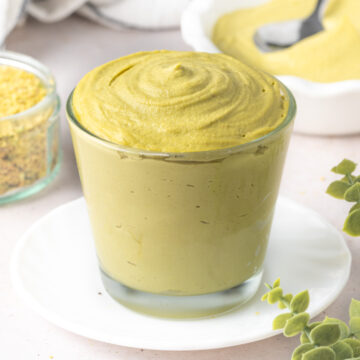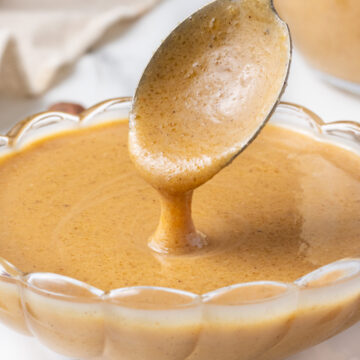This Vanilla Bean Crème Anglaise (Vanilla Custard Sauce) is a basic French Pastry recipe that can be used as a sweet sauce or as a base to make other desserts like ice cream or crème brûlée. It is made from 4 ingredients and only takes 15 minutes to prepare.
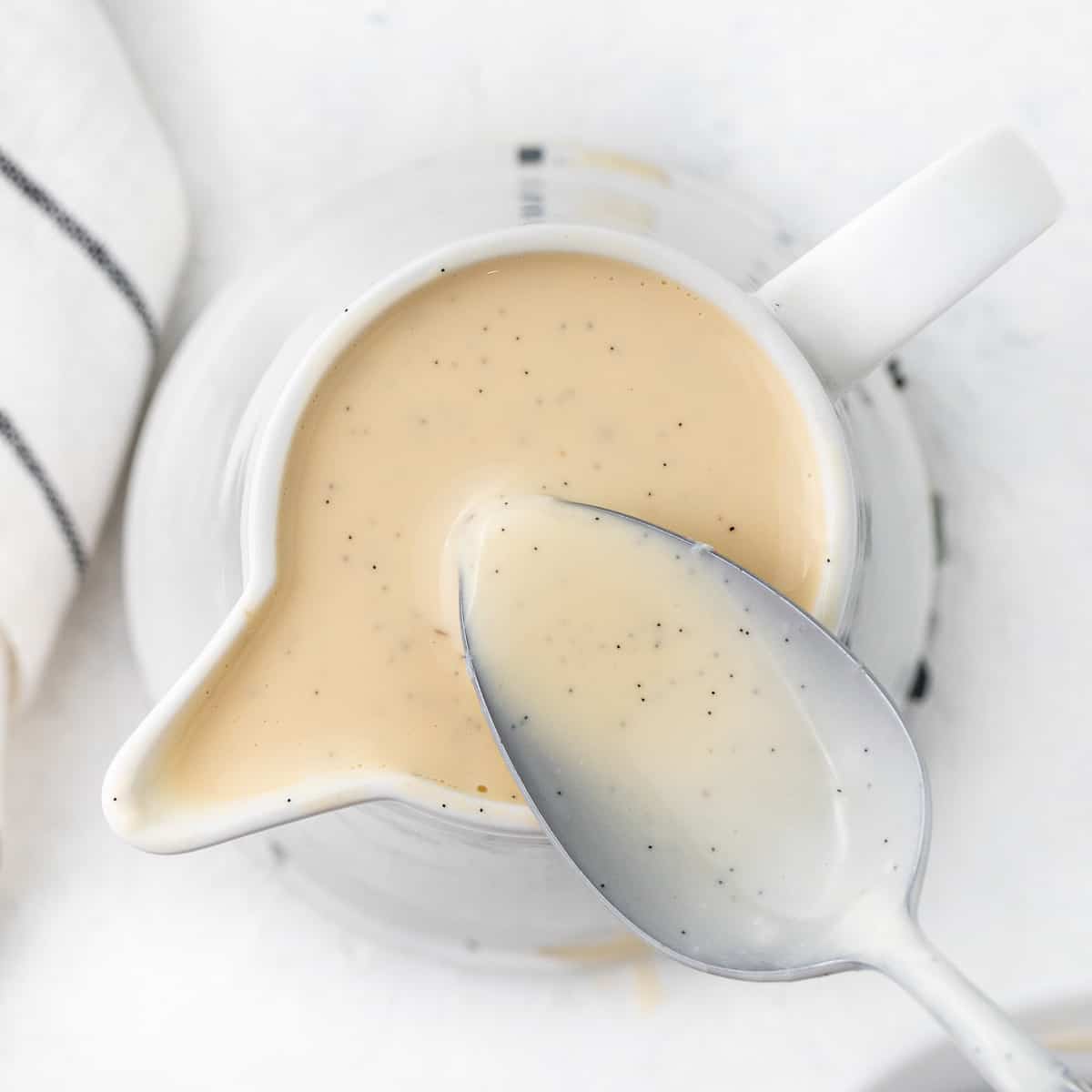
Jump to:
Why we love this recipe
Creme Anglaise is one of those super basic - but super versatile - French Pastry recipe. It is made from 3 basic ingredients (Milk, Egg Yolks and Sugar) and flavoured with Vanilla to create a deliciously fragrant, lightly sweetened sauce.
This pouring custard has an amazing smooth, thin and velvety texture that makes it the perfect sauce to drizzle over cakes, desserts or fruits. It is also a great basic recipe to master if you want to make homemade ice cream or other creams and desserts.
What is Crème Anglaise
"Crème Anglaise" (meaning "english cream" in French) is a basic French Pastry recipe that can be used as a sweet dessert sauce or as a based for other creams and desserts such as Ice Cream, Crème Brulée or Bavarian Cream.
The thin custard sauce is made from 3 basic ingredients that are cooked on the stove until it thickens. It is classically flavoured with vanilla bean but variation include coffee, chocolate or fruit custards.
Creme Anglaise is relatively similar to a Crème Pâtissière (pastry cream) in the way it is made. But does not use any cornstarch or flour to thicken it so its texture is lighter, thinner and more runny.
Ingredients

Scroll down to recipe card below for all quantities
What is Anglaise made of:
- Milk: use Whole Milk / Full Cream Milk for the best flavours and textures. Whole Milk contains around 3% of fat, giving extra richness to the sauce.
- Sugar: caster sugar or superfine white sugar. This recipe is relatively low in sugar, so if you are after a sweeter dessert, simply increase the quantity of sugar slightly.
- Egg Yolks: from large eggs. It is very important for the eggs to be at room temperature or they might curdle when you mix them with the warm milk. You can use the leftover egg whites to make Financiers for example.
- Vanilla Bean: you will want to use both the scraped seeds from inside the bean as well as the remaining pod to flavour the milk. It is important to let the vanilla infuse in the warm milk for at least 10 to 15 minutes in order to get the best flavours.
Substitution
- For a thicker, richer sauce, you could substitute half of the milk for thickened / heavy cream or half and half.
- Creme anglaise is one of those recipe where using a fresh vanilla pod is really worth it - but you could substitute it with vanilla paste if preferred. Vanilla extract will work but you will loose some flavour and those beautiful vanilla bean specks.
How to make Crème Anglaise step-by-step
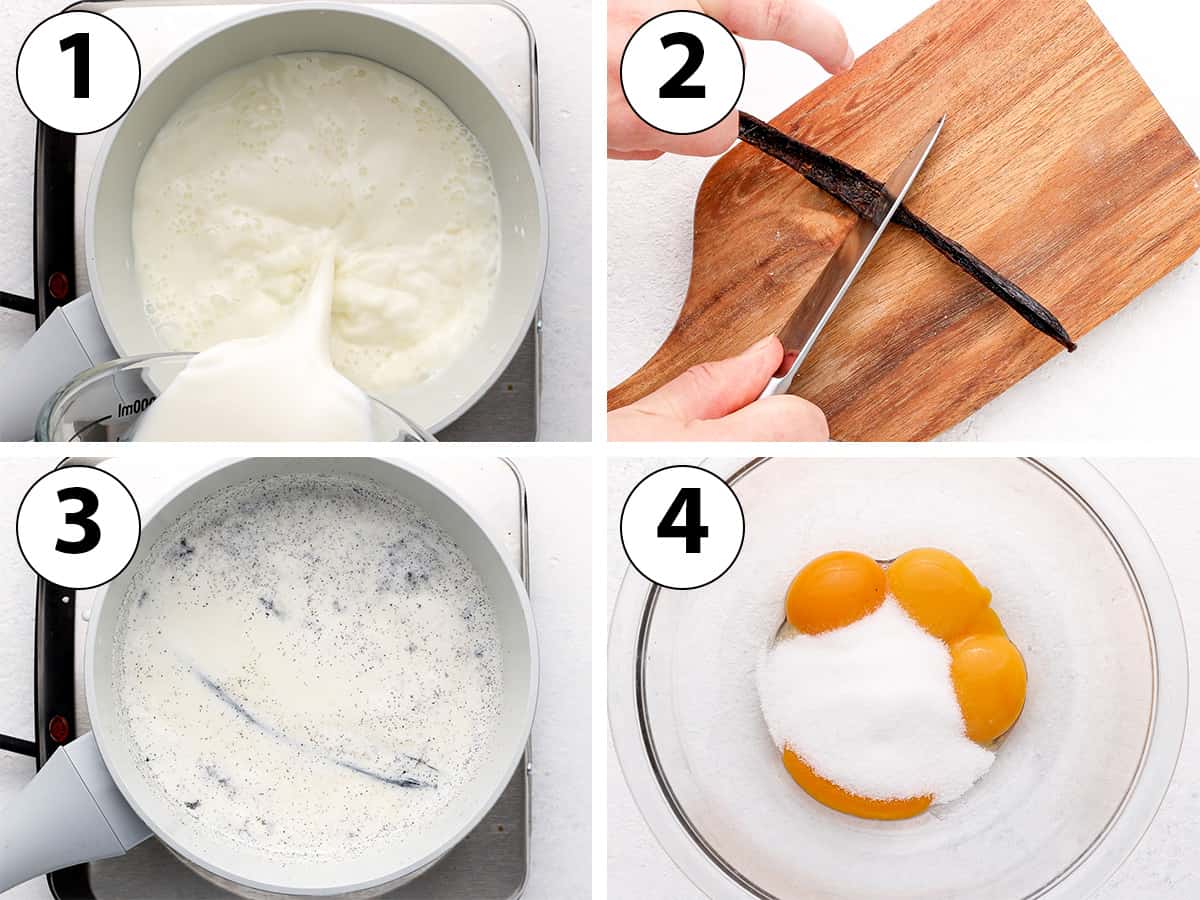
- Photo 1: Place the milk in a small to medium saucepan.
- Photo 2: Slice the vanilla bean in half and scrape off the seeds with a small parring knife.
- Photo 3: Place the vanilla seeds and the leftover pod in the saucepan with the milk.
- Turn on low heat and bring to a simmer while occasionally stirring. Once the milk starts to simmer, turn off the heat and cover the saucepan with a lid. Leave to rest for 10 to 15 minutes. Remove the vanilla pod (and keep it to make homemade vanilla extract for example).
This resting time will allow for the vanilla to infuse in the milk and give you more intense flavours. If you are using vanilla paste, there is no need to let it infuse in the milk.
- Photo 4: While the milk is infusing, place the egg yolks and sugar in a large heat proof bowl.
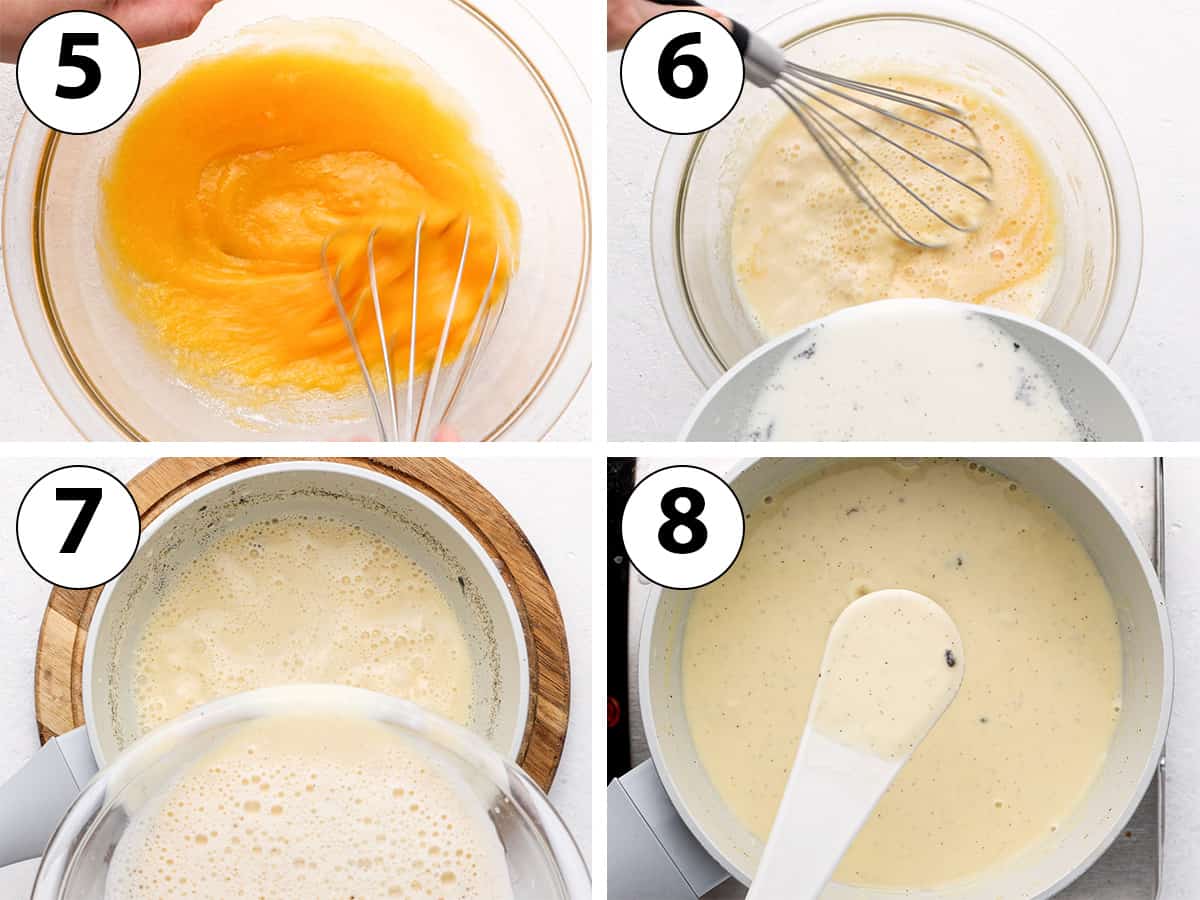
- Photo 5: Whisk the egg yolks and sugar for 1 minute or just until combined.
You want to avoid creating too many air bubbles so no need to whisk for too long.
- Photo 6: Slowly pour the hot milk mixture over the egg yolk mixture while constantly whisking.
This step is called "tempering" and it allows to slowly rise the temperature of the eggs. A sudden change of temperature could make the egg curdles or burn.
- Photo 7: Pour the whole mixture back into the saucepan and turn on low to medium-low heat.
- Photo 8: Cook for a few minutes while constantly stirring with a heat-proof spatula or wooden spoon. Don't let the mixture boil or it will overcook the eggs and you will get a lumpy custard.
- After about 5 minutes, once the cream reaches around 75 degrees Celsius and the bubbles disappear, the cream will start to thicken. Continue to cook for a few more minute or until it coats the back of a spoon and reaches around 82 degrees Celsius.
- Optionally, strain the cream through a fine-mesh strainer to remove any lumps or bits of cooked eggs.
Creme anglaise can be served warm or stored in the fridge in a clean jar / airtight container topped with plastic wrap touching its surface. The custard will thicken slightly once cool.
How to know that custard is done cooking
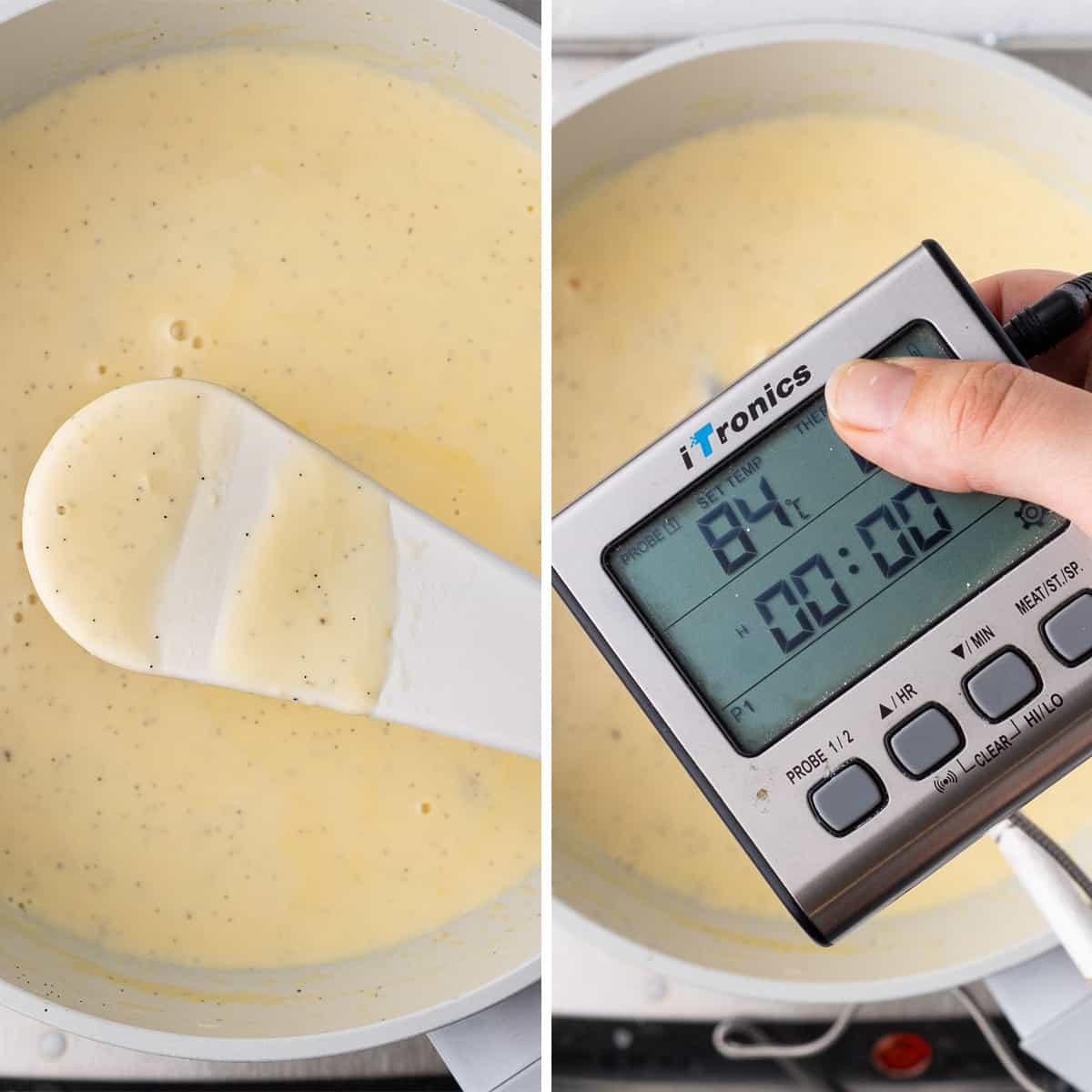
There are two ways to check if your creme anglaise is cooked: with the "coating" method or with a food thermometer.
- Coating Method ("à la nappe" in French): dip the back of a spoon or a spatula in the cooked cream and look at the consistency. If the mixture is very liquid and drips straight off, it is not ready. It the mixture is thick enough to coat the spatula and you can draw a clear line with your finger, it is ready.
- With a food thermometer: this is the most accurate way to check that your creme anglaise has been perfectly cooked. You want the custard to reach a temperature of 82 to 84 degrees Celsius (180 to 183 degrees Fahrenheit).
At this temperature, the egg yolks are perfectly cooked without starting to turn into scrambled eggs. Make sure to cook the custard under medium heat or it will cook too quickly and potentially give you a lumpy texture.

Recipe FAQs
The cooking methods and ingredients of creme anglaise and custard are quite similar. While a custard (or pastry cream / crème pâtissière) uses a starch or flour as a thickening agent, creme anglaise only relies on egg yolks to thicken, giving it a much thinner consistency.
The main difference between the creme anglaise vs creme patissiere is the texture. Creme anglaise should be thin, fluid and pourable, while pastry cream is richer and thick enough to be used as a topping or filling inside cakes, tarts and pastries.
This custard might be called a "cream", but it actually uses milk. The recipe will work if you substitute the milk with heavy cream (30% fat content), but you will get a different texture that is slightly thicker and richer in taste.
For its distinctive pouring consistency, you want to use milk. To use as a base for ice cream or creme brulee for example, milk is usually substituted with cream as those desserts require that extra fat content.
Unfortunately no; the egg yolks are what make the cream thicken so without out, you will be left with sweetened milk.
It is the egg yolks that are slowly cooked into the milk that give the slightly thick texture to the custard sauce. The mixture will thickened once the egg yolk reach the right temperature (around 82 degrees Celsius), then will continue to set slightly when cooled down.
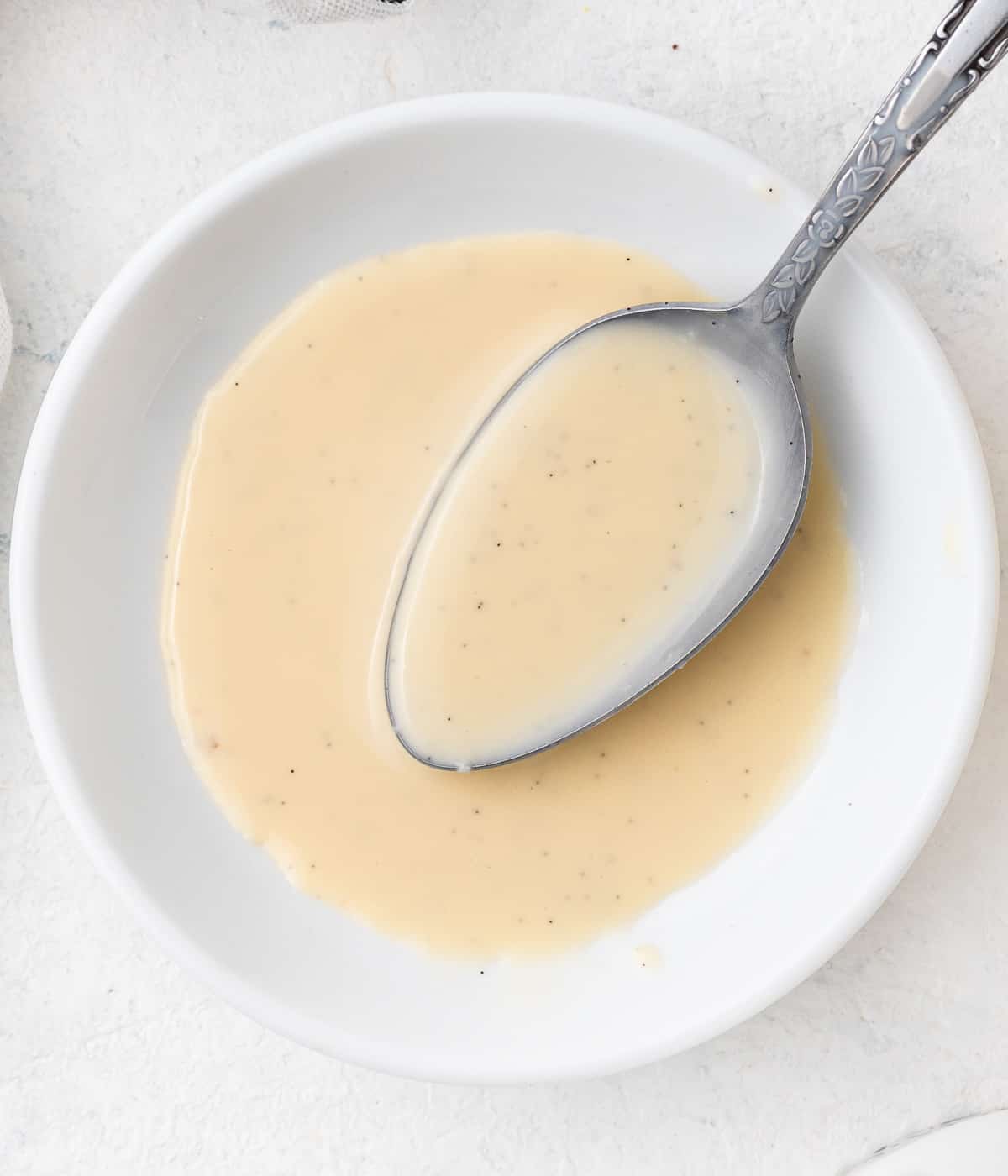
Texture & Flavour Variation
- Make it thicker: replace part of the milk (or all of the milk) with heavy / thickened cream - or add one more egg yolk more more richness.
- Add some spices or herbs to flavour the milk, such as Cinnamon, Cardamom, Nutmeg or fresh Mint and Basil.
- Turn it into a chocolate creme anglaise by adding some cocoa powder to the milk, or make the thicker chocolate version called Chocolate Crémeux.
- Replace part (or whole) of the milk with a strained fruit puree or fruit juice like lemon juice or strained strawberry puree.
- Flavour the milk with instant coffee or tea such as chai or matcha.
What is Crème Anglaise used for
This recipe for creme anglaise is super versatile and can be used in many different ways. The vanilla sauce can be used either hot or cold:
- As a sweet sauce over cakes like a Chocolate Fondant Cake or Chocolate Hazelnut Cake, tart and pies like French Apple Tart or breakfast dishes like Brioche French Toast.
- Simply served to accompany a fruit salad or fresh berries.
- Used as a base to make other desserts like bread pudding, Chocolate Crémeux, Bavarian Cream, Coffee Crème Brulée or Passion Fruit Ice Cream.
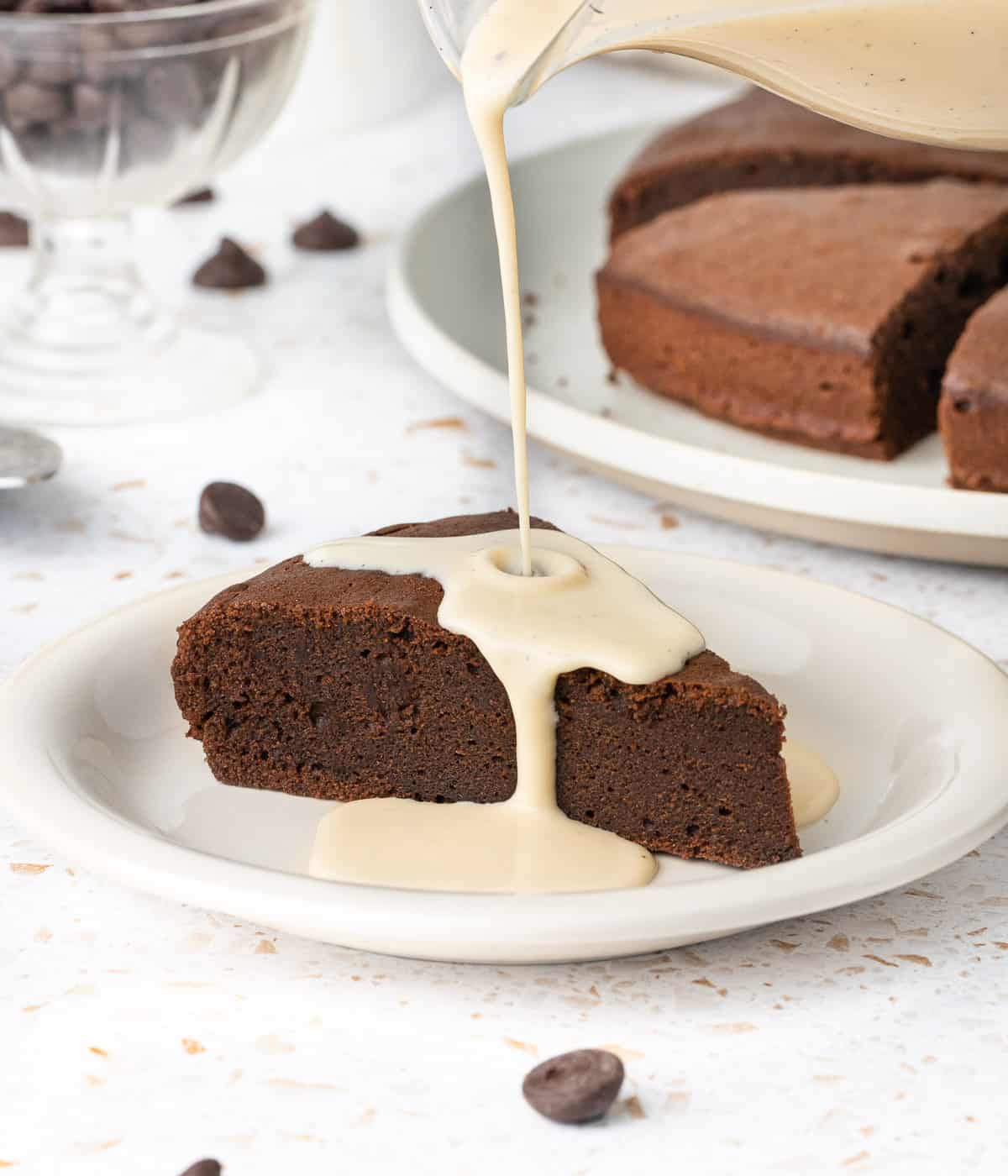
Tips & Troubleshooting
- Cooking the cream in a saucepan vs over a double boiler: the easiest way to avoid overcooking the cream is to cook it over a double boiler. This will heat up the cream more slowly but also more gently, giving you more control.
- How to keep creme anglaise from curdling: it is essential to cook the cream on a low temperature. If the heat is too high (or a change of heat that is too sudden), the egg yolks will start to scramble leaving you with a curdled custard. Make sure to constantly stir as the cream will cook more quickly at the bottom of the pan than at the top.
- How to save a lumpy custard: first, pour it through a thin mesh sieve to remove any large lumps. If the crème anglaise still appears to be grainy or lumpy, you can try to slowly mix it with an immersion blender to smooth it out.
- Why is my creme anglaise not thickening? Because we are cooking the mixture on a low temperature, it will take quite a few minutes to get it to thicken. The cream will also continue to thicken as it cools down. If you have cooked the cream to reach the right temperature but the mixture is still too thin, it is possible that you needed one extra egg yolks.
Storing & Freezing
This creme anglaise can be served straight away while still warm or kept in the fridge for up to three days. Simply let the cream cool down slightly then transfer into a jar or airtight container with a piece of plastic wrap touching its surface.
I do not recommend freezing creme anglaise as it can mess up its smooth texture.

Made this recipe?
Let us know if you liked it by leaving a comment below, and tag us on Instagram @a.baking.journey with a photo of your creation!
Recipe

Crème Anglaise (Vanilla Custard Sauce)
Ingredients
- 500 ml (2 cups) Full Cream / Whole Milk
- 1 fresh Vanilla Bean - or 2 teaspoon Vanilla Paste
- 4 Egg Yolks - at room temperature
- 60 gr (1/4 cup) Caster Sugar
Disclaimer
I highly recommend using the measurements in grams & ml (instead of cups & spoons) for more accuracy and better results.
Instructions
- Place the milk in a small to medium saucepan. Slice the vanilla bean in half and scrape off the seeds with a small parring knife. Place the vanilla seeds and the leftover pod in the saucepan with the milk then turn on low heat. Occasionally stir until the milk starts to simmer. Remove from the heat and cover the saucepan with a lid. Leave to rest for 10 to 15 minutes then remove the vanilla pod (see note 1).
- While the milk is infusing, place the egg yolks and sugar in a large heat proof bowl and whisk for 1 minute or just until combined. Slowly pour the hot milk mixture over the egg yolk mixture while constantly whisking (see note 2). Pour the whole mixture back into the saucepan and turn on low to medium-low heat.
- Cook for 5 to 10 minutes while constantly stirring with a heat-proof spatula or wooden spoon, or until the creme anglaise has thickened enough to coat the back of a spoon and has reached a temperature of 82 to 84 degrees celsius (180 to 183 degrees Fahrenheit). Don't let the mixture boil or it will overcook the eggs and you will get a lumpy custard.
- Optionally, strain the cream through a fine-mesh strainer to remove any lumps or bits of cooked eggs (see note 3).
- Use warm straight away or stored in the fridge in a clean jar / airtight container topped with plastic wrap touching its surface. The custard will thicken slightly more once cool.
Tried this recipe? Make sure to leave a comment and star rating below!
Notes
- This resting time will allow for the vanilla to infuse in the milk and give you more intense flavours. If you are using vanilla paste instead of a fresh vanilla bean, there is no need to infuse it. Make sure to keep the vanilla pod to make homemade vanilla extract for example.
- This step is called "tempering" and it allows to slowly rise the temperature of the eggs. A sudden change of temperature could make the egg curdles or burn.
- If you have overcooked the cream and still find it lumpy or grainy after having strained it, you can try to slowly mix it with an immersion blender to smooth it out.


